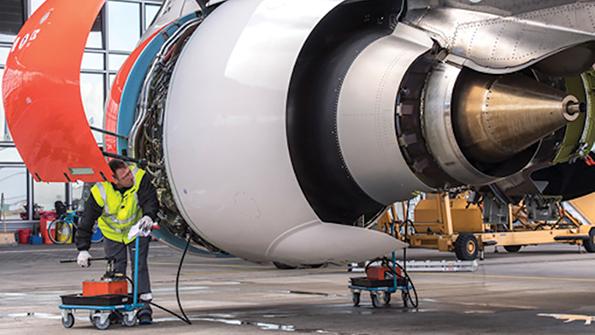さらに複雑化する、複雑なリース返却業務

航空機リースにおける機体やエンジンの返却プロセスは長い間、複雑かつ多くの場合コストがかかるものだと捉えられてきた。これには機材を適切な場所に再配置するためのロジスティクスや、現地で顧客や検査機関による点検を受け、リース条件に合致しているか確認する作業など、複数の要因がある。新型コロナウィルスの感染拡大により、世界的に国境をまたぐ航空機の移動が制限されたため、貸主・借受人双方にとってこのプロセスはさらに複雑になっている。
資産運用に強みを持つKV Aviation社のテクニカルディレクター・Allan Rennie氏は、4月に開催されたAviation Weekのオンラインセミナー「Assessing the Challenges of Lease Returns(リース返却の困難を検証)」の中で、「現在直面している最大の問題は旅行ができないことと、経由地に立ち寄ることすらできないことだ。航空機やエンジンを移動させるにも、海外からの渡航を禁止している国が複数存在するだけに難しい」と述べた。
機材の再配置に伴う困難を抜きにしても、リース返却プロセスに必要な人員を確保することも難しいことが明らかになってきた。「リース返却業務を実際に行うテクニカルコンサルタントを確保しようとすることも非常に難しい」「当社が利用している代理店の従業員は全て現地採用のため、リース返却がなされる地域によっては、必要な能力を持った人員をすぐに揃えることが困難だ」ともRennie氏は語る。
SMBC Aero Engine Lease社(住友商事と独MTU Aero Engines社の合弁会社)の最高技術責任者・Graeme Crickett氏も、コロナ危機の中で生じた人材不足について指摘している。「我々が抱えている最大の問題は、現地で引渡業務ができる人材を探すことだけでなく、航空会社との調整も進められないことだ」と話した。同氏は、コロナ危機で収益が激減した航空会社が、従業員の解雇や一時帰休措置を採っていることがその原因であると考えている。
同氏は、債務超過や財政難に直面している一部の航空会社の未来は業界全体が悲観しており、危機は少なくともあと3~4ヶ月は続くと予想している。資金・人材・政府支援の不足などに加え、特にワイドボディ機の運航会社が厳しい状況に陥る可能性を挙げ、「一部の航空会社は復活できないだろう」とも述べた。また、機材の発注キャンセルや新規契約の消滅は、メーカーより幾分影響は少ないものの、一部のMRO事業者にも影響を及ぼすと同氏は考えている。彼は「MRO業界は何年もかけて拡大を続けてきたが、ここで突然逆行することになった。これは強烈な連鎖反応だ」と語る。とはいえ、ポジティブな変化が皆無というわけではなく、アフターコロナの業界においては電子契約がより推進されることを期待している。
法律事務所Vedder Priceのパートナー・Bill Gibson氏は、コロナ危機以前は機材の再配置業務と、次の運航者への引渡業務の両方が複雑なものだったと語る。これには次の借受人との契約条件の調整から、電子登録に必要な事務処理としての書類へのサインや公証手続といった「より退屈な」複雑さに至るまで、複数の理由を挙げた。
同氏は、この現在進行形で形作られている環境においては、新しいアプローチが必要になると語る。「これらの複雑性のために事前から準備を進める必要があるとすると、これからはより長い時間軸で考えざるを得ない」とも話した。とはいえ、すでに今の段階でも彼はコロナ危機の影響を実感している。「時間の話で言えば、これらの複雑性や流動的なスケジュールにより、恐ろしい数の再配置スケジュールが変更になっており、これは問題を起こす可能性がある」と付け加えた。
KV Aviation社のRennie氏は、これらの複雑性が短期的に改善することはなく、しばらくは残るだろうと 考えている。「我々が直面している困難は、全ての国が渡航/入国制限を解除するまで、おそらく12~18ヶ月は続くだろう」と語る。さらなる搭乗前検査の追加といった感染拡大防止策が採られる可能性もあり、その場合はより渡航が難しくなることも考えられ、そこからの連鎖反応で航空機リースにも影響が出るだろう。同氏は「A地点からB地点に人を移動させることや、MRO/エンジン/機材返却ができる適切な人材を適切な場所に配置することなど、より多くの複雑性への対処が求められている」と締めくくった。
以上は、James PozziがInside MRO誌いた記事です。 Inside MRO誌は、民間航空機MROセクターの最新のトレンドとテクノロジーを調査しています。毎月の各号には、重要なテクノロジー、ビジネス、および運用上の意思決定に必要な情報が記載されています。さらに、加入者は月に1回発行されるAviation Week&Space Technologyを受け取ることができます。Inside MRO誌をもっと知りたい場合、こちらをクリックして下さい。
Lease returns for aircraft and engines have long been considered complicated and often costly processes. This is due to various factors such as the logistics of redelivering the asset to the right location and then having it inspected by the multiple parties involved in the handover to ensure lease terms are met. Since the outbreak of COVID-19 has restricted the movement of many aerospace assets across borders due to global travel shutdowns, these processes have become more complicated for lessors and lessees alike.
“The biggest problem that people are experiencing today is the inability to travel and the inability for people who are traveling to stop off. Moving aircraft and engines around is difficult, as there are a number of countries that are closed,” said Allan Rennie, technical director at asset management specialist KV Aviation, during Aviation Week’s “Assessing the Challenges of Lease Returns” webinar in late April.
Aside from redeploying the asset, getting access to the necessary manpower for the lease-return process is proving to be challenging. “Trying to get technical consultants into a position to actually do a lease return is also very difficult,” Rennie says. “The number of agencies we use are all employing local nationals to do their returns in their hometowns and countries, so as a result the skillset isn’t readily available, depending on where the return is actually taking place.”
Graeme Crickett, chief technology officer of SMBC Aero Engine Lease, also cites manpower issues emerging during the downturn. “Our greatest issue isn’t just trying to find somebody on-site to do our technical redeliveries for us, but also talking to the airlines,” he says. He attributes this to revenue-starved carriers laying off or furloughing employees in the wake of the novel coronavirus.
Crickett shares pessimism across the industry as a whole about the future for some carriers, with airline insolvencies and financial distress on the horizon, and he foresees the crisis lasting another 3-4 months at least. “Some airlines are not going to recover,” he says, citing a lack of cash, resources or government backing while also believing that some widebody operators could find conditions tough. The knock-on effects of aircraft order cancellations and the lack of new commitments are expected to affect not only OEMs but to a lesser extent some MRO shops, Crickett believes. “They’ve spent years scaling up and now suddenly have to turn back—that’s a huge knock-on effect,” he says. However, Crickett is hopeful that the industry will grasp the opportunity for a greater push toward e-signatures post-COVID-19, which would be a positive change.
Bill Gibson, a partner at law firm Vedder Price, says that before the novel coronavirus, both the redelivery of the asset along with the transition of an aircraft or engine to a follow-on operator were complicated procedures. He cites several reasons why this has been the case, ranging from reaching agreement between the lessor and follow-on lessee about the condition of the asset to “more prosaic” complications such as getting the necessary parties to sign documents and having them notarized or legalized as part of e-registration requirements.
In this still-evolving environment, Gibson says new approaches will be necessary. “If before all of these complications we were having to plan ahead, now we are really having to plan a longer timeline,” he says. However, even now he is already seeing the impact of COVID-19. “In terms of timing, we are seeing an awful lot of scheduled redeliveries move sideways just because of all these difficulties and at a fluctuant time, and that can create a problem.” he says.
Rennie of KV Aviation believes there likely will not be relief in the short term for these complications and sees them remaining for some time to come. “The difficulties we are seeing now will probably continue for the next 12-18 months until every country relaxes some of their travel and immigration policies,” he says. With the added possibility of further measures being imposed—such as screening passengers pre-flight—there are concerns that this may further deter travelers and lead to a further knock-on effect on the leasing of assets. “There’s going to be another level of complication getting people from A to B and, equally, getting the right people in the right place to do MRO returns, engine returns and aircraft returns—it’s another level of complication that we’ll have to work around.”